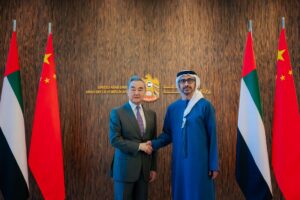Artificial Intelligence by China
Artificial Intelligence: Diplomacy & Dispute Settlement Techniques by China

American supply of advanced military technology, and presence through military bases in China’s regional sphere of influence. Dangerous developments are exacerbating preexistent security dilemmas and posing an existential threat to Chinese national security. Consequentially, the Peoples’ Republic of China (PRC), is pushed to incorporate Artificial Intelligence (AI) into its weapon system and public sectors.
The PRC announced to set up a local industry worth the United States (US) $ 150 billion. The rationale behind the incorporation of AI is to prepare the Chinese military for future warfare, prepare Chinese diplomats for future crisis management, and deal with social and societal issues. Research shows that between 2012-2017 various Chinese companies and many investors have spent and invested more than $400 Billion in the advancement of AI companies. It is more obvious that in the future China will lead the US and no one will stop it, as China has surpassed the US in AI research since 2016. Keeping in view of the 2030 vision, China is scoring high and pouring billions of dollars into the advancement of AI networks throughout the country. It is becoming inevitable for Beijing to retrofit the preexistent systems with, and incorporate AI into emerging technologies. Numerous facets of Chinese society, including the socioeconomic, military, and political spheres, have been significantly impacted by the rapid growth of AI in China. The major industries that will be most impacted by a rise in AI adoption are those that provide goods and services for transportation, accommodation, food, and agriculture.
This study discusses the use and, advantages of AI by PRC in future war planning. China tested AI-based Unscrewed surface vessels (USVs) in the South China Sea due to conflicting territorial and maritime claims with Taiwan, Vietnam, Indonesia, Malaysia, and the Philippines. Control over South China Sea means control over natural resources as this area has estimated 190 trillion cubic feet of natural gas and 11 billion barrels of untapped oil. USVs will help Peoples Liberation Army Navy (PLAN) to monitor activities of hostile forces in the area, timely detect encroachment into PRC’s territorial waters, detect adversary’s energy explorations, and oust foreign presence in PRC’s waters. Testing and the subsequent induction of USVs, therefore, had been a strategic necessity for Beijing. Future generations of USVs can be equipped with torpedoes, and electronic warfare capabilities to intercept or jam enemy communications or launch Kamikaze attacks against enemy vessels, submarines, and Unmanned Underwater Vehicles (UUVs). Moreover, AI systems can be used for securing digital files and upholding the stability of cyberspace. AI can play a vital role in defending infrastructure and various networks from cyber-attacks. With analysis based on data it may also support decision-makers and leaders.
The deployment of USVs/ UUVs or other AI-equipped platforms by PLAN is a countermove to prevent United States hostile moves. The American 2022 National Security Strategy (NSS) document publicly acknowledged that the US is engaged in long-term strategic competition with China.
The American development of micro alliances i.e., the QUAD, the AUKUS, and the evolving Washington- Tokyo- Manila trilateral strategic alliance targeted against Beijing. Further, Washington is expanding North Atlantic Treaty Organization (NATO) to the South China Sea. These military alliances aim at preventing the peaceful rise of China. Inference can be drawn that the future robotized warfare capabilities can change the regional status quo in PRC’s favour. Leading to the US-PRC AI arms race at strategic and operational levels. Washington’s proliferation of new weapon systems and technologies to its allies can become a challenge for Beijing’s future strategy. Weapons technologies proliferation can enable the former to overwhelm the adversary. Strategic advantages include gaining Anti Access/ Area Denial (A2/AD) capabilities, escalation dominance, and minimal economic/ human costs.
The prevalent international system and history of modern warfare ascertain that the PRC had neither invaded nor started a major war or occupied any country. It, nonetheless, will incorporate AI in weapon systems to locate the root causes of violence, enforce ceasefire, prevent escalation, manage crises, and prevent conflicts and future wars. Instead, AI algorithms will be used to evaluate historical data, geopolitical variables, and socioeconomic indicators. It will help decision-makers to pinpoint areas that are vulnerable to armed conflict. AI algorithm can be used in “the “Digital Silk Rod,” to enable partner countries to develop these technologies to preserve and promote international peace. China hopefully will use its clout on international stage to promote beneficial usage of AI i.e., support crisis management, creation of public policy, and monitor social media trends. Careful assessment of social media trends can prevent negative content from spreading in society leading to division of social fabrics, ethnic violence, religious hatred, communal fights etc. significant advancements and successes in AI-enabled technologies, could motivate partner countries to accelerate their own AI research and development efforts.
The substance of the matter is AI will be incorporated to identify eventual disputes and hotspots. Other areas include diplomacy, escalate peace, assess shatter belts, actively engage in peacekeeping, and prevent conflicts. The AI Diplomacy and dispute settlement techniques by Beijing will be aimed at deterring future wars.
Note: The views expressed in this article do not necessarily reflect those of ‘The Gulf Observer’.

